#Virtual Reality for Workforce Training
Explore tagged Tumblr posts
Text
In the rapidly evolving landscape of technology, virtual reality (VR) has emerged as a transformative force, reshaping industries and enhancing training methodologies. Among the pioneering virtual reality companies in India, Simulanis stands out, particularly in major cities like Delhi, Mumbai, and Noida. This blog will delve into what makes Simulanis a leader in the VR sector and how it is revolutionizing the way we approach virtual reality training in India.
#VR Training Solutions India#Virtual Reality Training Programs#VR-based Employee Training India#Immersive VR Training India#Virtual Reality for Industrial Training#VR Safety Training India#Corporate VR Training India#VR Skill Development India#VR Training for Manufacturing#Virtual Reality for Workforce Training#VR Simulations for Training India#VR Training for Healthcare India#Virtual Reality in Education India#VR for Skill Enhancement India#Interactive VR Training India#VR for Corporate Training India#Virtual Reality Safety Simulations India#VR Training Platforms India#Virtual Reality for Emergency Response#Next-gen VR Training India
0 notes
Note
interesting how they think dark romance is "grooming" women into being abused meanwhile actual right wing figures are trying to ban both books and porn...dark romance and romantasy are not the problem y'all
Lol yeeeep
And the sad thing is, a lot of supposed left-wingers have fallen for the "save the children (women) from sexual content" argument hook, line, and sinker. They've pushed the neopuritanical wave just as much as right-wingers have, just in different packaging.
Don't get me wrong: Porn can be harmful. Any sexual content, like virtually any content of any kind, has the potential to be harmful. But the reality is that pornography of some sort has always existed and will always exist. Just like (a lot of, but not all) people have always enjoyed an element of voyeurism. People like looking at art depicting sex. They like reading about sex. They like watching people fuck. There's a point where you have to just chalk it up to human nature. Again: NOT ALL PEOPLE. But most. Probably the vast majority, when you strip away hangups and society. And that's not me erasing those who don't; you are valid and your needs should be accommodated, and I frankly think they.... often are. Especially in this cultural moment.
But it's okay to want to consume explicit content, whether it's because it turns you on or just because... because.
There are many reasons why people perceive a porn problem, but the root of all evils is not that content. It's how we as a society treat it, and, on a basicl level, how we as a society expect and encourage people to fucking parent their children.
I so often see people say "But I don't want my kids to read those books" "I don't want my kid to watch that".
Dude. They most likely will if they want to. Even if that content is banned—and I hope it isn't, but I'm bracing myself, and a good cluster of states in the US, including blue ones, have essentially banned porn through age verification laws—people will find a way to access it. Just as they found a way to access alcohol, and weed, and so on. People do find a way to access that content in countries that currently ban porn.
So the thing is—you can either bury your head under the sand and train people to become weird about it... or you can have honest conversations and encourage healthy consumption. My mom told me that there was a difference between porn and reality. My mom read romance novels with me to get an idea of how I was consuming them (and it was fun, because I was lucky and had a pretty cool mom, overall).
And it bums me out, frankly, to see so many women act as if the "pornifiation of society" is what's keeping women down, versus the MUCH MORE PRESENT issues of like... the wage gap. Poor childcare options. The encouragement of the idea that having children is what you're meant for if you're born with a uterus. People trying to rape us all the time, which they ALWAYS HAVE, that's not porn! Red pilling, which is not a porn thing (a lot of red pills eschew porn!). Systemic racism and transphobia, which hits women of color and trans women, and as long as they don't have equal rights, women will not have equal rights.
Dark romance is not leading women down the tradwife lifestyle. You know what is? Christian indoctrination linking up to the crunchy granola girl pipeline. The mass spread of conspiracy theories and the twisting of gender essentialist "I know my body and therefore that of my child better than any dooooctooooor" bullshit that push the idea that you're this Earth Mother and not a normal human being. Not to mention a shitty economy, all those factors relating to women in the workforce I mentioned above, utilized to further push the idea that it would be soooo much easier if you just stayed at home with your babies. And then we throw in the dismantling of the public education system, which is only getting WORSE..... People are just less educated, and they want women to be less educated than men, and that has a LOT going on that has nothing to do with the dark romances women read.
And these people would probably be better able to think critically if not for those issues, so.
#romance novel blogging#another fun fact about my childhood is that i was homeschooled off and on#but it had nothing to do with religion; nope#my mom homeschooled us sometimes bc my dad moved us fucking everywhere and sometimes the school districts were horrid#and my mother had a degree in early childhood development and was in fact... a teacher#so she taught us! and she taught us well! and so much of our education was based in reading#and you know i thank her for it but i also sometimes wish i was less plugged in bc damn it's rough sometimes
43 notes
·
View notes
Text
Keys to the Digital Future
The digital future is not merely a continuation of today’s technological trends; it is a transformative landscape where innovation, connectivity, and sustainability intertwine to redefine how we live, work, and interact. As we step into this exciting future, understanding its essential components can empower individuals, businesses, and societies to thrive. Here are the key elements shaping the digital future:
Artificial Intelligence (AI) and Machine Learning (ML)
AI and ML are at the forefront of the digital transformation. These technologies are driving advancements in automation, data analysis, and decision-making. From personalized recommendations to autonomous vehicles, AI’s capabilities are reshaping industries. The future lies in ethical AI development, ensuring these tools enhance human lives while minimizing biases and risks.
The Internet of Things (IoT)
The IoT connects devices, systems, and people, creating an ecosystem of interconnectivity. Smart homes, wearables, and industrial IoT solutions are just the beginning. As 5G and edge computing mature, IoT’s potential to streamline operations and improve efficiency will expand exponentially, transforming everything from healthcare to urban planning.
3. Sustainable Technologies
The digital future must align with global sustainability goals. Renewable energy, energy-efficient data centers, and green computing practices are essential for reducing the environmental footprint of technology. The circular economy, which emphasizes recycling and repurposing electronic waste, will play a significant role in creating a sustainable digital ecosystem.
Cybersecurity and Privacy
As technology evolves, so do the threats associated with it. Cybersecurity is a cornerstone of the digital future, requiring robust frameworks to protect data and infrastructure. Privacy-centric technologies, such as blockchain and zero-knowledge proofs, offer innovative ways to safeguard user data and build trust in digital systems.
Digital Inclusion and Accessibility
A truly transformative digital future is one that is inclusive and accessible to all. Bridging the digital divide requires investments in infrastructure, affordable devices, and digital literacy programs. Technologies must be designed with accessibility in mind, ensuring equitable opportunities for everyone, regardless of location, ability, or socioeconomic status.
Quantum Computing
Quantum computing has the potential to solve problems that are currently beyond the reach of classical computers. By leveraging quantum mechanics, these machines can revolutionize fields such as cryptography, drug discovery, and climate modeling. While still in its infancy, quantum computing is a critical component of the digital frontier.
The Metaverse and Virtual Realities
The metaverse represents the convergence of physical and digital realities. Virtual and augmented reality technologies are enabling new ways of interaction, education, and entertainment. Businesses are leveraging these immersive environments for training, product design, and customer engagement, laying the foundation for a blended digital-physical world.
Ethical Leadership in Technology
The digital future demands leaders who prioritize ethics and societal well-being. From addressing algorithmic biases to ensuring responsible AI deployment, ethical leadership is crucial for fostering innovation that aligns with human values. Transparency, accountability, and collaboration will be key to navigating complex ethical challenges.
Education and Lifelong Learning
As technology evolves, so must our skills. The future workforce will require adaptability and continuous learning to keep pace with new tools and paradigms. Education systems must evolve to emphasize digital literacy, critical thinking, and collaboration, preparing individuals for the demands of a rapidly changing digital landscape.
Global Collaboration
The digital future is a global endeavor, requiring collaboration across borders, industries, and disciplines. Shared goals, such as mitigating climate change and advancing healthcare, necessitate partnerships that leverage collective expertise and resources. International cooperation will ensure that technological advancements benefit humanity as a whole.
The keys to the digital future lie in innovation, inclusivity, and sustainability. By embracing these principles and addressing the challenges they present, we can unlock unprecedented opportunities for growth and prosperity. As we navigate this dynamic journey, the digital future promises to be a realm of endless possibilities, limited only by our imagination and commitment to shaping it responsibly.
2 notes
·
View notes
Text
Rajasthan Launches AVGC-XR Policy 2024: A Step Toward Transforming the State’s Digital and Creative Industries

In a bold move to foster innovation and boost the state’s economy, the Rajasthan government recently launched the AVGC-XR Policy 2024. This policy aims to position Rajasthan as a leader in the rapidly growing sectors of Animation, Visual Effects, Gaming, and Comics (AVGC), as well as Extended Reality (XR). With the launch of this policy, Rajasthan is setting its sights on becoming a key hub for digital entertainment, immersive technology, and creative industries.
What is the AVGC-XR Policy 2024?
The AVGC-XR Policy 2024 is a strategic initiative by the Rajasthan government to promote the development of the AVGC and XR sectors in the state. It aims to create a sustainable and dynamic ecosystem that supports the growth of digital entertainment, gaming, animation, visual effects, and immersive technologies like virtual reality (VR) and augmented reality (AR). By leveraging the increasing demand for digital content and XR experiences, the policy seeks to establish Rajasthan as a global player in the creative and technology-driven industries.
This policy introduces several measures to support businesses, encourage talent development, and create a vibrant ecosystem for innovation and entrepreneurship. By fostering these industries, the Rajasthan government aims to boost employment, attract investments, and enhance the state’s global visibility in the digital world.
Key Features of the AVGC-XR Policy 2024
Financial Support and Incentives for AVGC and XR Companies The policy offers financial incentives for businesses operating in the AVGC and XR sectors. This includes subsidies, tax exemptions, and financial assistance to help businesses establish themselves and grow in the state. The policy also provides funding for startups involved in creating content, technology solutions, and other digital products in these sectors. These incentives will significantly reduce the initial investment burden on businesses, encouraging them to innovate and expand.
Skill Development and Talent Pool Creation One of the most crucial aspects of the AVGC-XR Policy 2024 is its focus on skill development. The policy recognizes the importance of a skilled workforce in driving the growth of the AVGC and XR industries. It proposes the establishment of training institutes and skill development programs specifically designed for animation, gaming, visual effects, XR technologies, and other digital content creation fields.
By investing in skill development, the government hopes to create a large pool of talent that can meet the growing demands of the industry. This will also ensure that Rajasthan becomes a talent hub for the national and international AVGC and XR sectors.
Infrastructure and Ecosystem Support The policy recognizes that the growth of the AVGC and XR industries requires robust infrastructure. To address this need, the Rajasthan government plans to develop dedicated clusters and innovation hubs for AVGC and XR businesses. These clusters will be equipped with the latest technology, high-speed internet, and collaborative workspaces that encourage innovation and creativity.
Additionally, the government will focus on creating a supportive ecosystem by collaborating with industry leaders, universities, and global players. This will help create an environment where companies can easily access resources, partnerships, and global markets.
Promotion of Rajasthan as a Global AVGC and XR Hub A significant goal of the AVGC-XR Policy 2024 is to make Rajasthan a global destination for the AVGC and XR industries. The policy outlines various strategies to promote the state’s capabilities in these sectors, including hosting international events, film festivals, and conferences. Rajasthan aims to attract global industry leaders, filmmakers, and content creators by offering them a conducive environment for collaboration, production, and innovation.
By leveraging the state’s rich cultural heritage and growing technological capabilities, Rajasthan plans to position itself as a leading center for digital content creation and immersive technologies.
How Will This Policy Benefit Rajasthan?
Job Creation and Economic Growth The AVGC-XR Policy 2024 is expected to generate significant employment opportunities in Rajasthan. By promoting industries such as animation, gaming, and visual effects, the state can create thousands of new jobs in creative fields, technology development, and digital content production. The policy will also encourage the growth of ancillary industries, such as software development, digital marketing, and content distribution, further boosting the state’s economy.
Attracting Investments and Global Partnerships With the implementation of this policy, Rajasthan is poised to attract both domestic and international investments in the AVGC and XR sectors. The incentives offered by the government will encourage investors and companies to establish operations in the state, which will bring in capital, expertise, and technological advancements. The policy’s focus on global partnerships will also help connect Rajasthan’s industries with the global market, creating new avenues for collaboration and growth.
Boosting Rajasthan’s Global Presence in the Digital and Creative Sectors The policy will put Rajasthan on the map as a hub for digital entertainment and immersive technology. Through various promotional strategies, including international events, film festivals, and business partnerships, the state will enhance its visibility in the global digital and creative industries. This increased global presence will attract global talent, increase tourism, and further promote Rajasthan’s cultural and technological strengths.
Fostering Innovation and Entrepreneurship The AVGC-XR Policy 2024 will encourage innovation and entrepreneurship in the state by providing financial support, infrastructure, and a collaborative ecosystem for startups. The government’s focus on creating innovation hubs will foster a culture of creativity and technology-driven entrepreneurship, enabling businesses to experiment, innovate, and grow.
The Future of Rajasthan’s AVGC and XR Industries
With the launch of the AVGC-XR Policy 2024, Rajasthan is set to become a major player in the digital entertainment and XR sectors. By investing in infrastructure, skill development, financial support, and global partnerships, the state is creating a conducive environment for businesses to flourish. The policy aligns with the growing global demand for digital content, animation, gaming, and immersive experiences, positioning Rajasthan as a key contributor to this dynamic sector.
As the world continues to embrace digital technologies and immersive experiences, the AVGC-XR Policy 2024 will provide Rajasthan’s businesses with the tools and resources needed to thrive in these fast-evolving industries. Whether you are an entrepreneur, investor, or creative professional, the policy offers numerous opportunities for growth, innovation, and success.
The AVGC-XR Policy 2024 is a significant milestone for Rajasthan in its journey to become a global leader in digital content creation and immersive technologies. With its comprehensive approach to infrastructure, talent development, financial support, and global promotion, the policy is set to revolutionize the AVGC and XR sectors in the state. For businesses and individuals in these industries, Rajasthan offers an exciting future full of opportunities to innovate, collaborate, and succeed in the global marketplace.
As the state continues to build on its strengths, the AVGC-XR Policy 2024 will undoubtedly help Rajasthan carve out a prominent place on the global digital map.
3 notes
·
View notes
Text
The Conscript Nurse Lifestyle

is a carefully structured and standardized approach to nursing that aims to create a cohesive, disciplined, and efficient workforce of healthcare professionals. Consisting of various elements, this lifestyle emphasizes androgynous presentation, professional grooming, and uniformity among nurses to foster a sense of unity and dedication to patient care.

Key aspects of the Conscript Nurse Lifestyle include:
Androgynous Presentation: Nurses undergo special training and grooming to achieve an androgynous appearance. This involves shaving their heads, weight loss, toning their bodies to become lean, and utilizing cosmetics and skincare to maintain a uniform, polished look.
Uniform: Consistent with the androgynous presentation, nurses wear a standardized, one-piece white uniform. The uniform is designed to symbolize professionalism, cleanliness, and dedication to their role.
Alpha Numeric Designators: Instead of using traditional names, nurses are assigned non-gendered alpha numeric designators. This measure is implemented to protect patient privacy and foster a professional environment while promoting a sense of unity among the nursing staff.
Specialized Training: Nurses undergo rigorous training, including neuro-psychological programming and virtual reality-based simulations, to enhance their skills, adaptability, and decision-making abilities. This ensures they are well-prepared to handle a wide range of medical situations efficiently.
Disciplined Lifestyle: Nurses adhere to a disciplined lifestyle, including regular physical fitness routines, adherence to strict diets, and weekly reinforcement sessions. These practices are designed to maintain peak physical and mental performance, as well as reinforce the commitment to their profession.
Chastity Devices: Similar to other conscripted roles, the Conscript Nurse Lifestyle involves wearing chastity devices during duty hours to maintain focus on patient care and professional boundaries.
Adherence to Protocols: Conscript nurses are expected to strictly adhere to established healthcare protocols and standardized procedures, ensuring consistency and precision in their care delivery
Restricted Personal Freedom: During their conscript service, nurses may experience limited personal freedom due to strict protocols and regulations. They may be prohibited from pursuing certain recreational activities or having unregulated social interactions to maintain focus on their duties.
Communal Living: Conscript nurses may live in communal dormitory-style accommodations provided by the nursing corps. This living arrangement fosters camaraderie and unity among the nursing staff.
Restricted Mobility: While on duty, conscript nurses' movements may be closely monitored and restricted to ensure prompt responses to patient needs and maintain a disciplined work environment.
Performance Evaluation: Conscript nurses are subject to regular performance evaluations to ensure compliance with established standards and protocols. Positive performance is often rewarded with recognition and privileges within the corps.

19 notes
·
View notes
Text
Virtual Reality in Manufacturing Education: Benefits and Challenges
As manufacturing rapidly evolves with digital transformation, automation, and stricter safety standards, traditional training methods like lectures and manuals are falling short. Virtual reality (VR) is stepping in to revolutionize manufacturing education by offering immersive, hands-on learning in risk-free digital environments. It enables workers to practice complex procedures safely and efficiently. While the benefits are significant—enhanced retention, standardized training, and safety—adopting VR at scale comes with its own set of challenges that organizations must navigate.
The Benefits of VR in Manufacturing Education
Immersive, Risk-Free Learning
One of VR’s greatest strengths is its ability to create high-fidelity, interactive simulations that mirror real-life manufacturing scenarios. Learners can engage in realistic tasks without the fear of injury or equipment damage. This encourages confidence and experimentation, which are essential to skill mastery.
Standardized, Scalable Training
Consistency is critical in industrial training. With VR, every learner—regardless of location or instructor—receives the same content, cues, and assessment metrics. This ensures standardization, especially in global manufacturing operations, where uniform compliance and skills proficiency are non-negotiable.
Faster Knowledge Retention
VR activates multiple senses, leading to improved engagement and memory retention. Learners absorb information faster when they experience it rather than passively read about it. This active learning model has been shown to reduce training time significantly while boosting long-term recall.
Data-Driven Insights
Modern VR platforms offer real-time analytics. Educators and trainers can monitor performance metrics like reaction time, accuracy, and procedural adherence. These insights help identify skill gaps early and tailor learning pathways to individual needs—something nearly impossible in traditional training setups.
Safe Simulation of Rare Scenarios
Certain manufacturing incidents—like chemical spills, fires, or system failures—are difficult and dangerous to simulate in live training. VR can recreate these situations realistically, helping trainees practice responses without compromising safety.
Challenges of Integrating VR into Manufacturing Education
Despite its clear advantages, the integration of VR isn’t without its friction points. Understanding these challenges is essential for successful adoption.
High Initial Investment
While VR training reduces long-term costs, the initial setup—hardware, software development, content customization, and technical support—can be expensive. Many small to mid-sized manufacturers struggle to justify these upfront expenses without a clear ROI roadmap.
Content Relevance and Customization
Generic training modules may not align with specific company processes or equipment. Customizing content for a particular factory setup requires collaboration between subject matter experts and VR developers, which can extend development timelines.
Resistance to Change
Veteran workers accustomed to hands-on, traditional methods may be skeptical of VR-based learning. Overcoming this mindset requires change management strategies, including pilot programs, peer testimonials, and gradual rollout plans.
Technical Barriers
VR systems require a certain level of digital literacy and infrastructure. In regions with limited connectivity and tech skills, implementing VR training at scale can pose difficulties.
The Path Forward: Learning with XR Guru
As the manufacturing sector continues to embrace digital transformation, VR training is emerging as a vital tool in workforce development. The benefits clearly outweigh the challenges—if the right partners are involved.
That’s where XR Guru comes in. With a laser focus on immersive, industry-specific learning, XR Guru offers a comprehensive suite of VR solutions tailored to the unique needs of the manufacturing industry. From safety protocols and machine operation to situational awareness and emergency response, our expertly designed modules bring manufacturing education into the modern age.
In a world where precision, agility, and safety define success on the production floor, VR education—powered by platforms like XR Guru—is not just a supplement. It's a necessity.
For more information, visit: https://www.xrguru.com/virtual-reality-in-manufacturing
0 notes
Text
Chris Bressi Champions Smart Tech for Smarter Classrooms

A Visionary Educator for a Tech-Driven Future
As the educational landscape undergoes rapid transformation, driven by technology and innovation, few voices have been as influential and forward-thinking as Chris Bressi. Based in Downingtown, Pennsylvania, Bressi is not only a passionate advocate for student-centered learning but also a leader in integrating smart technology into classrooms to foster engagement, personalization, and real-world readiness. His approach reflects a powerful synergy between pedagogy and cutting-edge tools — a combination that is reshaping how educators teach and students learn.
Smart Classrooms: The New Normal in 21st Century Education
Gone are the days when a chalkboard and textbook defined a classroom. Today, smart classrooms are equipped with tools like interactive whiteboards, AI-powered tutoring systems, and real-time analytics platforms. For Chris Bressi, this isn’t just a trend — it’s a necessity.
Bressi believes that students growing up in the digital age deserve educational environments that mirror the tech-driven world they live in. According to him, smart classrooms help bridge the gap between traditional instruction and the skills required in the modern workforce, such as collaboration, critical thinking, and digital literacy.
The Role of Chris Bressi in Promoting EdTech Solutions
Chris Bressi has spent much of his career advocating for the use of smart technology in education, from elementary schools to high school settings. As an educational consultant and thought leader, Bressi advises schools on how to adopt scalable technology solutions that do more than just digitize the curriculum — they transform the learning experience.
He emphasizes tools such as:
Artificial Intelligence (AI) for personalized instruction
Virtual Reality (VR) for immersive simulations
Learning Management Systems (LMS) for tracking progress
Data dashboards that help educators monitor engagement and tailor instruction
By introducing these tools, Bressi enables schools to create environments where students are not just passive learners but active participants in their educational journey.
Empowering Teachers with Smart Tools
One of Bressi’s most enduring messages is that technology should support educators, not replace them. He works closely with teachers to ensure they’re not overwhelmed by new systems. Instead, he promotes professional development models that gradually integrate smart tools into lesson plans.
According to Chris Bressi, “When teachers are trained to use smart technologies effectively, it enhances their ability to differentiate instruction, manage their classrooms, and keep students engaged — not just in content, but in the joy of learning.”
From webinars and digital toolkits to hands-on workshops, Bressi’s programs are designed to build educator confidence and competence in using tools like Google Classroom, Nearpod, and AI grading assistants.
Student-Centered Learning Through Smart Tech
At the heart of Bressi’s philosophy is the belief that students learn best when their education is personalized. Smart technology plays a vital role in this. Tools such as adaptive learning platforms allow teachers to adjust content based on a student’s strengths, weaknesses, and pace.
Bressi also emphasizes project-based learning enhanced by tech. For instance, students can collaborate on Google Docs, present findings using digital storytelling tools, or simulate historical events using VR. This type of learning is not only engaging but also equips students with practical tech skills they’ll use throughout their lives.
Real-World Impact: Success Stories from Downingtown
In his work with the Downingtown Area School District and surrounding communities, Chris Bressi has helped usher in transformative changes. Schools that have adopted his smart classroom strategies report increased student engagement, better academic outcomes, and more motivated teachers.
A Downingtown teacher who worked with Bressi commented, “Chris helped us move from fear to confidence. The transition to tech-enhanced instruction was smoother than we imagined — and now I can’t picture teaching without it.”
These success stories are testaments to Bressi’s ability to inspire action and create meaningful change at the ground level.
Challenges and Solutions: Navigating the Digital Divide
Bressi acknowledges that not every school has equal access to technology. One of the challenges in adopting smart classrooms is the digital divide — the gap between students who have access to reliable tech and those who don’t.
To address this, Bressi works with schools and districts to identify low-cost or grant-supported solutions. He also promotes equitable access initiatives, such as:
Device loan programs
Community Wi-Fi partnerships
Open-source software adoption
His commitment is clear: technology must not deepen inequity — it must be a bridge to opportunity for all students, regardless of their background.
Looking Ahead: What’s Next for Smart Classrooms?
For Chris Bressi, the journey is just beginning. He envisions a future where classrooms are not confined by walls but extended through global connections, AI-powered learning, and collaborative digital spaces. Some of the emerging trends he champions include:
AI tutors that learn with the student
Blockchain for academic record verification
Augmented Reality (AR) field trips
Gamification of assessments
Bressi continues to work with educators, technologists, and policymakers to ensure these innovations are introduced responsibly, ethically, and effectively.
Conclusion: Chris Bressi’s Enduring Legacy
Chris Bressi work in promoting smart technology is more than a contribution to education — it’s a revolution in how we think about learning. His unwavering belief in the power of technology, paired with a deep respect for educators and students, is what sets him apart.
As schools around the world grapple with the challenge of preparing students for an uncertain future, voices like Chris Bressi remind us that with the right tools and vision, that future can be bright, equitable, and inspiring.
#Chris Bressi#Smart Classrooms#Educational Technology#Chris Bressi Downingtown#AI in Education#Classroom Innovation
0 notes
Text
Virtual Reality (VR) in Healthcare Market Redefines Mental Health Treatment Dynamics by 2032
The Virtual Reality in Healthcare Market Size was valued at USD 3.20 billion in 2023 and is expected to reach USD 46.40 Billion by 2032, growing at a CAGR of 33.30% from 2024-2032.
Virtual Reality in Healthcare Market is witnessing accelerated adoption as medical professionals and institutions embrace immersive technology to enhance patient care, training, and diagnostics. From surgical simulations to mental health therapy, VR is proving transformative across multiple healthcare segments, especially in developed markets where digital infrastructure is robust and innovation is prioritized.
U.S. Sees Rapid Uptake in VR-Driven Medical Innovations Across Clinical and Educational Settings
Virtual Reality in Healthcare Market continues to gain ground as the technology matures and becomes more accessible to both practitioners and patients. The growing emphasis on precision medicine, remote collaboration, and experiential learning is driving wider application of VR in hospitals, medical schools, and rehabilitation centers.
Get Sample Copy of This Report: https://www.snsinsider.com/sample-request/2820
Market Keyplayers:
Osso VR- Surgical Training Platform
Medivis - Anatomical VR Surgical Visualization
MindMaze - MindMaze Health
VRHealth - VRHealth Hub
Surgical Theater - Precision VR
Augmedics - xvision Surgical Augmented Reality System
ImmersiveTouch - ImmersiveTouch Surgical Simulation
Virtual Reality Medical Center (VRMC) - VR Therapy for PTSD and Anxiety
Simulated Surgical Systems - Surgical Simulators for Training
EchoPixel - True 3D Viewer
HoloAnatomy - HoloAnatomy Software
Strivr - VR Training Solutions for Healthcare
EVA Health - EVA: Virtual Reality Pain Management
Auris Health - Monarch Platform for Robotic-Assisted Surgery
DeepStream - Virtual Reality Therapy Solutions
Rendever - Virtual Reality Experiences for Seniors
Unimmersive - VR Pain Management Platform
Physitrack - Telehealth & Rehabilitation Software
Karuna Labs - VR for Cognitive Behavioral Therapy
Pillars of Wellness - VR Mindfulness and Wellness Programs
Market Analysis
The rise of virtual reality in healthcare is propelled by the convergence of advanced imaging, AI, and real-time simulation tools. Healthcare providers are increasingly turning to VR to reduce procedural errors, improve patient engagement, and accelerate recovery through gamified rehabilitation. In the U.S., the integration of VR is further supported by government-backed digital health initiatives, while Europe continues to lead in research-backed VR therapy applications.
Market Trends
Growing adoption of VR for surgical planning and simulation
Integration of VR in physical and occupational therapy
Use of VR environments for mental health and PTSD treatment
Training modules for medical students using immersive scenarios
Deployment of VR in pain distraction during procedures
Increased funding and partnerships between tech firms and hospitals
Rise in consumer-facing VR wellness apps for stress and anxiety
Market Scope
The scope of the Virtual Reality in Healthcare Market is expanding beyond experimental uses to become a core component of modern care delivery. As devices become more affordable and software more specialized, VR is scaling into mainstream medical workflows.
Clinical diagnostics and treatment simulations
Neurological and psychological therapy tools
Immersive training for medical staff and students
Post-surgical recovery enhancement through guided VR programs
Cross-functional application across cardiology, orthopedics, and oncology
VR-enabled remote consultations for isolated patients
Forecast Outlook
The Virtual Reality in Healthcare Market is set for robust growth, driven by ongoing R&D, regulatory support, and increasing digital maturity in the healthcare ecosystem. Both the U.S. and European regions are expected to lead in adoption and innovation, fueled by rising healthcare demands, workforce training needs, and a shift toward tech-enhanced patient experiences. The future outlook suggests deeper integration of VR with AI, cloud platforms, and data analytics to deliver smarter, personalized, and immersive care solutions.
Access Complete Report: https://www.snsinsider.com/reports/virtual-reality-in-healthcare-market-2820
Conclusion
As the healthcare industry continues its digital evolution, virtual reality stands out as a game-changer in how care is delivered, experienced, and optimized. Whether enhancing a surgeon’s precision in the U.S. or supporting VR-based PTSD recovery programs in Europe, the technology is not just futuristic—it’s foundational. For healthcare stakeholders, investing in VR is more than a trend; it's a strategic step toward transformative patient care.
About Us:
SNS Insider is one of the leading market research and consulting agencies that dominates the market research industry globally. Our company's aim is to give clients the knowledge they require in order to function in changing circumstances. In order to give you current, accurate market data, consumer insights, and opinions so that you can make decisions with confidence, we employ a variety of techniques, including surveys, video talks, and focus groups around the world.
Related Reports:
Contact Us:
Jagney Dave - Vice President of Client Engagement
Phone: +1-315 636 4242 (US) | +44- 20 3290 5010 (UK)
Mail us: [email protected]
0 notes
Text
Revolutionize Your Enterprise with Simulanis VR & AR
The future of business is immersive, interactive, and driven by technology. Enterprises that embrace Virtual Reality (VR) and Augmented Reality (AR) are unlocking new levels of efficiency, engagement, and innovation. At Simulanis, we are revolutionizing industries with cutting-edge VR and AR solutions that transform workforce training, customer experiences, and operational workflows.

Why VR & AR Are Essential for Enterprise Growth?
🔹 Next-Generation Employee Training Traditional training methods are no longer enough. Simulanis VR training solutions create realistic, hands-on virtual simulations, allowing employees to practice in a risk-free environment. AR-assisted learning further enhances training by providing real-time digital overlays and interactive guidance.
🔹 Enhanced Customer Engagement & Product Visualization Enterprises can showcase products and services in 3D, offering customers an immersive and interactive buying experience. VR-powered virtual showrooms and AR product visualization tools help businesses boost sales and brand loyalty.
🔹 Operational Efficiency & Safety Improvements From industrial safety training to real-time AR-powered remote assistance, immersive technologies help enterprises reduce risks, improve accuracy, and enhance productivity. AR smart glasses and VR simulations empower teams to perform complex tasks with greater precision.
🔹 Immersive Collaboration & Remote Work Solutions With VR-powered virtual workspaces, businesses can conduct meetings, training sessions, and brainstorming workshops in a realistic, collaborative digital environment. This is the future of hybrid work models and global enterprise connectivity.
🔹 Seamless Integration with the Metaverse The Metaverse is redefining business interaction, allowing enterprises to build virtual spaces, host digital events, and create next-level customer experiences. Simulanis provides tailored Metaverse solutions that help businesses stand out in the digital landscape.
Industries Benefiting from Simulanis VR & AR Solutions
✅ Manufacturing & Industrial Training – VR-based process training, equipment simulations, and AR maintenance guides. ✅ Healthcare & Medical Training – Surgical simulations, medical procedures training, and AR-assisted diagnostics. ✅ Retail & E-Commerce – Virtual try-ons, 3D product showcases, and interactive shopping experiences. ✅ Education & Corporate Learning – Engaging VR classrooms, AR-based learning modules, and enterprise e-learning solutions. ✅ Real Estate & Architecture – Immersive virtual property tours, 3D architectural visualizations, and interactive design planning. ✅ Automotive & Engineering – VR for vehicle prototyping, driver training, and AR-powered repair assistance.
Why Choose Simulanis?
At Simulanis, we are pioneers in VR, AR, and Metaverse technology, helping businesses unlock the full potential of immersive solutions. Our expertise in Extended Reality (XR) solutions ensures that enterprises can streamline operations, enhance customer engagement, and train employees more effectively.
🚀 The future of enterprise innovation starts now! 🚀
📩 Get in touch with Simulanis today and explore how VR & AR can transform your business!
Visit Website: simulanis.com
#Virtual Reality (VR)#Augmented Reality (AR)#Mixed Reality (MR)#Metaverse Solutions#Extended Reality (XR)#Enterprise VR Solutions#AR for Business#Immersive Technology#Future of Work#Digital Transformation#VR Training Programs#AR Training Modules#Industrial VR Training#Corporate Learning with XR#3D Virtual Simulations#AR Product Visualization#Workforce Training Solutions#Metaverse for Enterprises#Remote Work with VR#AI-Powered AR/VR#Smart Manufacturing with XR#VR for Employee Development#Augmented Reality for Retail#Virtual Showrooms#AR Maintenance & Support#VR in Healthcare & Medical Training#Immersive Learning Solutions#AR/VR for Real Estate#Enterprise Innovation with XR
0 notes
Text
XR and AI for Fast, Good, and Easy Maintenance

Introduction to XR and AI in Maintenance
Keeping equipment up and running efficiently is vital for any industry. That’s where XR and AI step in, changing how we manage maintenance tasks. From identifying issues faster to guiding technicians through complex repairs, XR and AI technologies are helping businesses reduce downtime, cut costs, and make operations smoother.
In this blog, we’ll explore how XR and AI make maintenance not just faster and better, but also easier than ever before.
What Are XR and AI in Maintenance?
XR, or Extended Reality, blends real and virtual environments using Augmented Reality (AR), Virtual Reality (VR), and Mixed Reality (MR). Meanwhile, AI (Artificial Intelligence) brings in smart automation, learning capabilities, and predictive analytics. Together, XR & AI offer a powerful toolkit for diagnosing, repairing, and optimizing machinery with incredible precision and speed.
Faster Maintenance with XR and AI
Real-Time Visual Guidance
AR glasses or headsets can overlay step-by-step repair instructions onto a machine, helping technicians fix problems on the spot. AI adds real-time diagnostics to guide the process even more efficiently.
Predictive Maintenance using XR and AI
AI algorithms analyze equipment performance and predict issues before they happen. Combined with XR dashboards, maintenance teams can see exactly where to focus attention, reducing emergency breakdowns.
Remote Expert Assistance
XR platforms allow remote experts to guide on-site workers visually, using AR tools. AI enhances this by providing translation, transcription, and data retrieval instantly, making collaboration seamless.
Better Maintenance Quality with XR and AI
Intelligent Troubleshooting
AI can sift through logs, sensors, and historical data to identify the root cause of a problem. XR devices then guide the technician through the exact solution path, minimizing guesswork.
Consistency and Accuracy
Using XR with AI, businesses can ensure that maintenance procedures are followed correctly every time. This reduces human error and improves the quality and consistency of work.
Data-Driven Insights
Maintenance histories, equipment lifecycles, and performance trends are tracked and visualized using XR dashboards and AI analysis, helping managers make smarter decisions.
Easier Processes and Less Downtime
Hands-Free Assistance
With AR wearables, workers can access instructions, diagrams, and even checklists hands-free, reducing interruptions and boosting safety.
Automated Scheduling and Alerts
AI systems can automatically plan maintenance schedules, send alerts, and allocate resources efficiently, freeing teams from routine admin tasks.
Simplified Training
VR simulations powered by AI create immersive training programs. New technicians can practice procedures virtually before stepping into the field.
Industries Benefiting from XR and AI in Maintenance
Manufacturing
Predictive repairs, real-time fault detection, and digital twin models.
Energy & Utilities
Remote inspections, guided maintenance, and smart scheduling.
Aviation
Pre-flight checks, engine diagnostics, and technician training using XR.
Automotive
Assembly line repair assistance and vehicle diagnostics powered by AI.
Challenges to Consider in XR and AI
Cost of Technology: High initial investment in XR devices and AI platforms.
Workforce Training: Technicians need time and support to adapt to the tools.
System Integration: Connecting XR and AI tools with legacy systems can be complex.
The Road Ahead
As XR and AI continue to advance, we’ll see even more intuitive tools like voice-activated repair guides, AI-enhanced visual recognition for fault detection, and smarter automation. Maintenance will become faster, more reliable, and highly optimized.
Conclusion
The future of industrial maintenance is here, and it’s smarter, faster, and easier. XR and Artificial Intelligence are helping companies move from reactive repairs to proactive precision. Whether you’re in manufacturing, energy, or transportation, adopting XR and AI for maintenance isn’t just an upgrade—it’s a game-changer.
Want to streamline your maintenance operations with XR and AI? Contact Modnexus to explore custom solutions that keep your systems running smarter, safer, and longer.
0 notes
Text
Why VR Trainings Are a Game-Changer for Manufacturing Operations
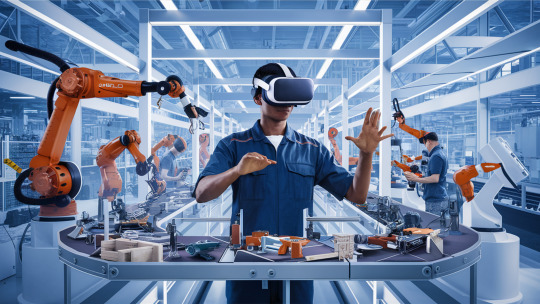
In the ever-evolving landscape of manufacturing, companies are constantly seeking innovative ways to enhance productivity, efficiency, and safety. One such groundbreaking solution is Virtual Reality training. By immersing employees in realistic, simulated environments, VR training offers unparalleled opportunities for skill development and safety training. Let’s explore how VR training is transforming the manufacturing industry.
Types of VR Training in Manufacturing
1. Safety Training
VR can simulate hazardous scenarios, allowing workers to practice safety protocols without real-world risks. This includes handling machinery, working in high-risk areas, and responding to emergencies. Employees can repeatedly practice their responses to potential accidents, ensuring they are well-prepared for any situation.
2. Equipment Handling:
Training employees on complex machinery can be costly and time-consuming. VR offers a cost-effective solution by providing hands-on experience with virtual models of equipment. Trainees can interact with detailed virtual replicas of machinery, learning operational procedures, troubleshooting, and maintenance without the risk of damaging expensive equipment.
3. Assembly Line Training:
VR can replicate assembly line processes, enabling workers to understand and master their roles before stepping onto the actual floor. This includes learning the sequence of operations, identifying potential bottlenecks, and practicing time management to optimize productivity.
4. Maintenance Training:
Technicians can learn to diagnose and repair machinery in a virtual environment, reducing downtime and improving efficiency. VR training can cover routine maintenance tasks, emergency repairs, and advanced diagnostics, ensuring technicians are well-equipped to handle any issue that arises.
Benefits of VR Training in Manufacturing
Enhanced Safety
VR training reduces workplace accidents by allowing employees to practice in a risk-free environment.
Cost-Effective:
It minimizes the need for physical resources and equipment for training purposes.
Improved Retention:
Interactive and immersive training experiences lead to better retention and understanding of skills.
Scalability:
Training solutions can be easily scaled and customized to suit the needs of different employees and departments.
Conclusion
The integration of VR training in manufacturing is revolutionizing the industry by providing a safe, efficient, and cost-effective method for training employees. As the technology continues to evolve, the possibilities for VR training are limitless. For any VR training solutions, contact DevDen, a leading VR development company, and unlock the full potential of your workforce with VR manufacturing training.
#augmented reality#metaverse#virtual reality#mixed reality#vr training solution#vr training#3d product modeling#xr development#xr development company#ar development company#ar app development#vr development company
0 notes
Text
The Future of AI in Manufacturing: Trends to Watch in 2025
Artificial Intelligence (AI) is no longer a futuristic concept in manufacturing—it’s a present-day powerhouse reshaping every corner of the industry. As we move through 2025, the integration of AI technologies is accelerating, driving smarter production lines, optimizing operations, and redefining workforce dynamics. Here’s a deep dive into the most transformative AI trends set to shape the manufacturing landscape in 2025 and beyond.

1. Hyperautomation and Autonomous Factories
In 2025, manufacturing is leaning heavily into hyperautomation—the orchestration of advanced technologies like AI, machine learning (ML), robotics, and the Industrial Internet of Things (IIoT) to automate complex processes.
Autonomous factories, where machinery self-monitors, self-adjusts, and even self-repairs with minimal human intervention, are becoming a reality. These smart factories rely on real-time data, predictive analytics, and AI-driven systems to make instant decisions, optimize throughput, and reduce downtime.
Key Example: Tesla and Siemens are pushing the envelope with AI-powered factories that adapt on the fly, resulting in faster production cycles and improved product quality.
2. Predictive and Prescriptive Maintenance
Maintenance is no longer reactive. In 2025, manufacturers are using AI to forecast when equipment will fail—before it happens.
Predictive maintenance uses historical data, sensor input, and AI models to detect anomalies. Prescriptive maintenance goes a step further by recommending specific actions to avoid failures.
Benefits include:
Reduced unplanned downtime
Lower repair costs
Prolonged equipment life
Stat Insight: According to Deloitte, predictive maintenance can reduce breakdowns by 70% and maintenance costs by 25%.
3. AI-Enhanced Quality Control
AI vision systems are revolutionizing quality assurance. In 2025, computer vision combined with deep learning can identify even microscopic defects in real time—far beyond the accuracy and speed of human inspectors.
Trends in 2025:
Real-time defect detection
AI models trained on vast image datasets
Adaptive quality control systems that learn and evolve
Industries like automotive and semiconductor manufacturing are already deploying these systems for better precision and consistency.
4. Generative Design and Digital Twins
Generative design, powered by AI, allows engineers to input goals and constraints, and the software suggests thousands of design variations optimized for performance and manufacturability.
Digital twins—virtual replicas of physical assets—are now powered by AI to simulate, predict, and optimize production performance. These twins learn from real-world data and provide insights into:
Product development
Production efficiency
Predictive simulations
By 2025, the synergy between digital twins and AI will allow real-time optimization of complex manufacturing ecosystems.
5. AI in Supply Chain Optimization
In a post-pandemic world, supply chain resilience is critical. AI is key to making supply chains smarter, more responsive, and adaptable to disruptions.
2025 Trends:
Real-time inventory tracking and demand forecasting
AI-driven supplier risk assessments
Automated logistics route optimization
By crunching vast datasets, AI ensures materials arrive just in time, reducing costs and delays.
6. Human-AI Collaboration and Upskilling
The narrative isn’t AI vs. humans—it’s AI with humans. In 2025, manufacturers are investing heavily in reskilling and upskilling their workforce to work alongside AI tools.
Examples include:
AR/VR interfaces for AI-assisted training
Human-in-the-loop systems for decision validation
AI-powered cobots (collaborative robots) working side-by-side with technicians
Companies are rethinking workforce models, blending human creativity with AI precision to create agile, future-ready teams.
7. Sustainability Through AI
Sustainability is no longer optional—it’s a strategic imperative. Manufacturers are leveraging AI to minimize waste, reduce energy consumption, and ensure greener operations.
How AI is enabling sustainability in 2025:
Smart energy grid management in factories
Optimization of raw material use
Real-time emissions monitoring
Sustainable manufacturing not only meets regulatory demands but also aligns with growing consumer and investor expectations.
Conclusion: AI as the Backbone of Smart Manufacturing
2025 marks a pivotal year in the evolution of AI in manufacturing. From autonomous operations to sustainable production, AI is not just a tool—it’s becoming the backbone of modern manufacturing. The companies that lead this transformation will be the ones that embrace AI’s potential, adapt quickly, and invest in both technology and talent.
As innovation continues to evolve, one thing is clear: the factories of the future are intelligent, efficient, and deeply interconnected—with AI at the core.
0 notes
Text
Trained
Unlike the LifeGuards or Security Forces, the Paramedic Corps requires a highly trained workforce. With shorts conscription periods maintaining sufficient training was a challenge.
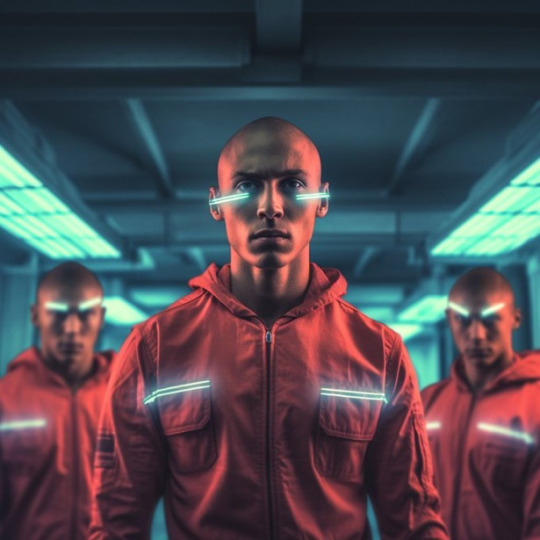
Classroom based training, trying to get pre trained cadets and so on didn’t provide enough staff. So scientist developed instruction techniques that are based on deep brain stimulation.
Devices were crude in the beginning and needed lots of attention, fitting needed time.
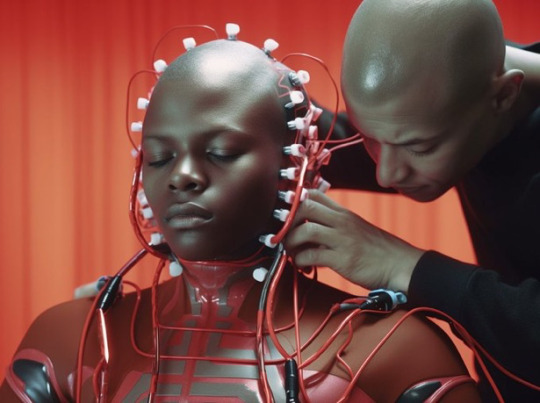
Moreover the prices was painful as sometimes electrodes were drilled into the trainees skull. But the technology proofed successful and was able to install medical and procedural knowledge into the brains of new Paramedic Corps members in short period.
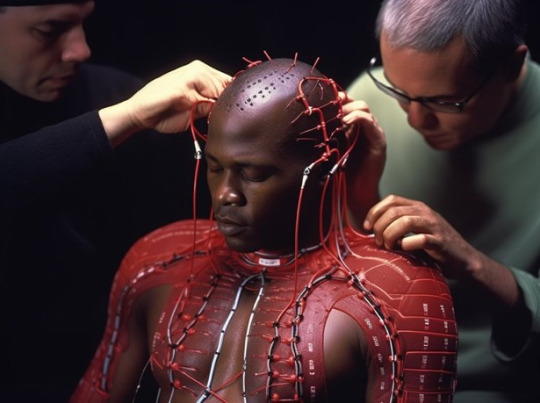
Later electrodes only had to be attached to the shaved skull of the trainee. The technology became more widespread and shortened training periods.
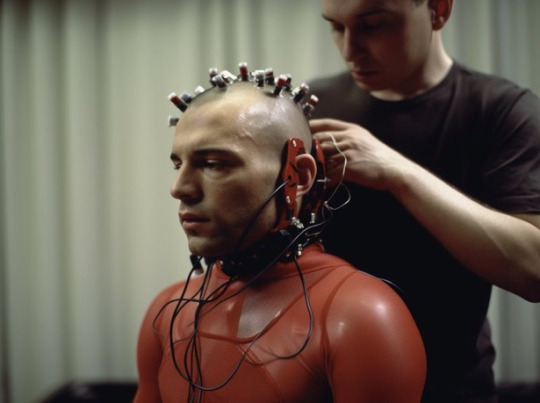
Nowadays different system exists on the market, some include VR based scenarios and brain stimulation. Trainee Paramedics pass a lot of time in these systems and learn how to respond.
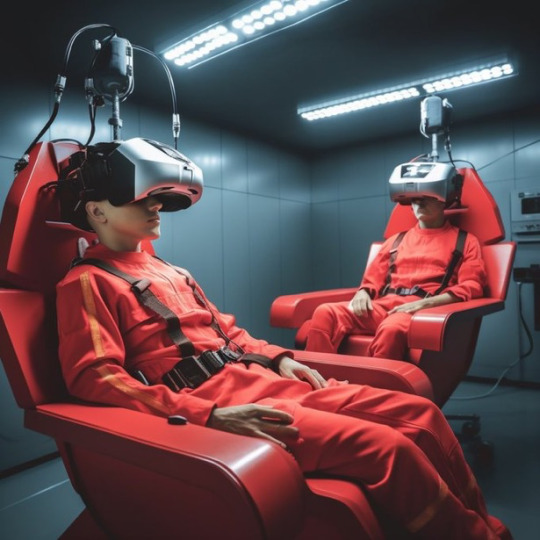
P4TZ9: “The VR environments we are immersed in allow us to practice and refine our skills in realistic emergency scenarios. While the benefits of this training approach are undeniable, the prolonged exposure to virtual realities can sometimes leave us feeling disconnected”

“The use of DBS learning technologies involves the stimulation of specific brain regions to enhance cognitive functions and accelerate learning. By targeting neural pathways associated with critical decision-making and medical knowledge retention”
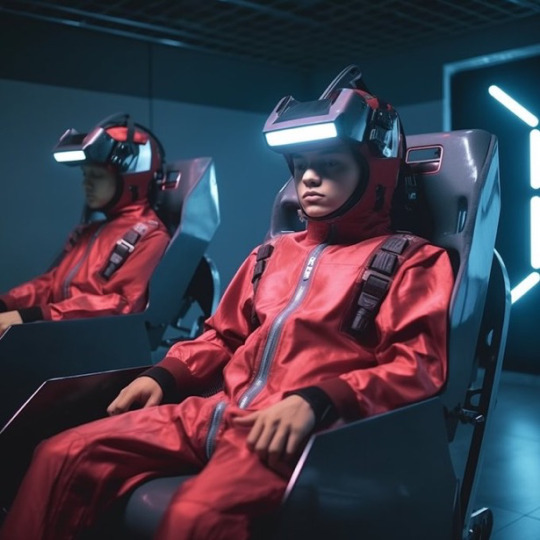
“To ensure the safety and well-being and effectiveness of the training program, the new paramedics are not allowed to leave to leave the training premises for the first four months. This is due the need to maintain a low stimulation environment and mitigate the potential…

negative effects of the training. It ensures that they have ample time for rest, recovery, and reflection between intense training sessions. This will help minimize the risk of mental and physical burnout.

By providing a controlled and low stimulation environment, we can maximize the effectiveness of the training program this includes dimmed light, no loud noises, bland food and strict schedules.

There's a sense of detachment that comes with it. A feeling of being disconnected from your own thoughts and emotions. “It's as if I'm on autopilot, functioning solely on the instructions and information provided.”, says IK46SL
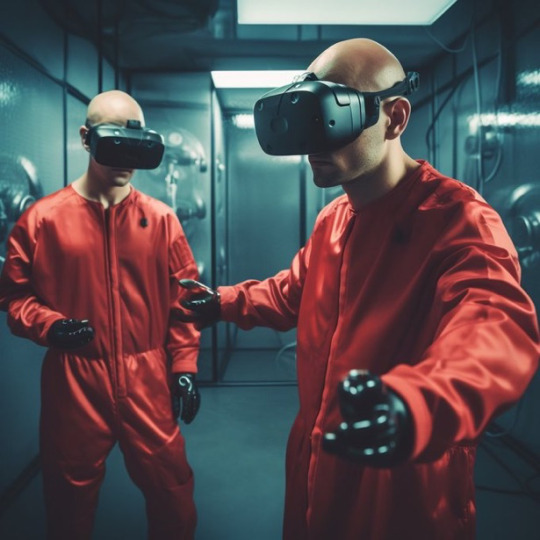
4 notes
·
View notes
Text
Augmenting HR: Innovations in AR, VR & Workplace Culture
As technology evolves at a rapid pace, human resources is stepping into a new dimension — quite literally. Augmented Reality (AR) and Virtual Reality (VR), once limited to gaming and entertainment, are now transforming how companies train, engage, and connect with their workforce. These immersive technologies are not just futuristic tools — they are practical, powerful solutions reshaping workplace culture and the way people experience work itself. In this blog, we explore how AR and VR are revolutionizing HR practices and building stronger, smarter, and more human-centered organizations.
Transforming Training Through Immersive Learning :
One of the most impactful applications of AR and VR in HR is in employee training and development. Instead of traditional classroom sessions or static e-learning modules, companies are using VR simulations to recreate real-life scenarios — from operating machinery to navigating complex customer service interactions. This hands-on experience improves knowledge retention, reduces on-the-job errors, and boosts employee confidence. AR adds an extra layer by overlaying digital instructions onto physical environments, making processes easier to learn in real-time. As a result, immersive learning is quickly becoming the new standard for effective workplace training.

Enhancing Recruitment and Onboarding Experiences :
AR and VR are also revolutionizing recruitment and onboarding processes. VR can offer virtual office tours or realistic job previews, helping candidates understand company culture and day-to-day expectations before they accept an offer. Meanwhile, AR tools can guide new hires during onboarding by overlaying information onto physical workspaces or systems. These technologies not only speed up integration but also create engaging, memorable first impressions. Companies leveraging immersive tech in recruitment often stand out as innovative and forward-thinking — a major plus in today’s competitive talent market.
Building Connection in Hybrid and Remote Workplaces :
In an era of remote and hybrid work, maintaining human connection and team cohesion is one of HR’s biggest challenges. VR offers virtual meeting rooms, collaboration hubs, and social lounges where employees can interact as avatars in 3D spaces — creating a sense of presence that video calls simply can’t match. AR can enhance this further by allowing real-time collaboration over shared documents, designs, or dashboards, even from different physical locations. These innovations foster inclusivity, improve communication, and make remote work feel more connected and dynamic.
🌐 www.gamecircuit.pro | 📞 +447463151997 | Play. Create. Dominate
#ARinHR#VRinHR#ImmersiveHR#FutureOfWork#HRTech#WorkplaceInnovation#VirtualReality#AugmentedReality#DigitalTransformation#EmployeeExperience#TechInHR#MetaverseWorkplace#XRinBusiness#VirtualOnboarding#ImmersiveLearning#HybridWork#RemoteWorkTech#WorkplaceCulture#HRInnovation#PeopleTech
0 notes
Text
Boost Efficiency with Virtual Reality in Manufacturing!

Virtual reality in manufacturing is streamlining processes, from assembly line training to equipment maintenance. XR Guru’s immersive VR platform enhances workforce skills and reduces downtime through realistic simulations. Manufacturers leveraging VR see improved precision, faster onboarding, and fewer errors. Stay ahead of the competition with XR Guru’s innovative VR solutions designed for the modern factory floor.
0 notes
Text
Why FlyAFE is the Leading Aviation Institute in Lucknow
In today’s rapidly expanding aviation industry, proper training is not just a necessity—it’s the foundation for a successful and long-term career. With new opportunities emerging in pilot training, ground operations, aviation engineering, and air traffic control, students across India are actively seeking institutions that offer quality education, hands-on training, and strong placement support.
FlyAFE, based in Lucknow, has emerged as a front-runner in aviation education, helping students turn their aviation dreams into reality. What sets FlyAFE apart from others in the region? Let’s explore the key reasons why FlyAFE is considered the leading aviation institute in Lucknow.
1. An Institution Built on Excellence
FlyAFE (Aviation Flight Education) has steadily built a reputation for delivering top-notch training and producing aviation professionals who excel in their respective fields. Over the years, the institute has grown into a trusted name among aspiring pilots and aviation technicians due to its strong curriculum, professional faculty, and student-focused approach.
FlyAFE is known for maintaining high standards in both classroom instruction and practical training. Whether you're preparing for a cockpit role or a behind-the-scenes technical career, FlyAFE ensures you're fully equipped to enter the workforce with confidence.
2. Industry-Standard Flight Training
When it comes to hands-on flight experience, FlyAFE sets itself apart with its sophisticated simulation labs and experienced flying instructors. The institute offers extensive in-aircraft training combined with virtual simulator sessions that replicate real-world flying conditions.
As a recognized flying school in Lucknow, FlyAFE provides aspiring pilots with the opportunity to train on modern aircraft, using tools and systems found in commercial airlines. This real-world exposure allows students to master navigation, communication, emergency protocols, and flight safety under the guidance of certified professionals.
The goal is simple: to create skilled, confident pilots who are ready for both national and international aviation roles.
3. Diverse Course Offerings Across Aviation Fields
FlyAFE offers a wide range of aviation-focused programs that cater to different career paths, including pilot training, cabin crew programs, ground operations, and aircraft maintenance. Whether you want to be in the air or on the ground, there’s a program that aligns with your aspirations.
Unlike many smaller training centers, FlyAFE functions as a full-fledged aviation institute in Lucknow, offering DGCA-approved courses and certifications. These programs are designed to meet the global standards required for aviation professionals today.
The curriculum is a mix of theory, field exercises, and communication skills to ensure students become well-rounded candidates when entering the job market.
4. Expert Faculty with Real-World Experience
An institution is only as strong as its mentors, and FlyAFE has a team of highly experienced instructors. The faculty includes former airline captains, certified aircraft engineers, and industry experts who bring their wealth of knowledge into every session.
This practical insight adds tremendous value to students’ learning. Instead of only relying on textbook material, students get to learn from real-life scenarios, case studies, and industry best practices.
More importantly, instructors provide mentorship—helping students make better career decisions, improve their confidence, and prepare for interviews and licensing exams.
5. High-Tech Infrastructure and Practical Labs
FlyAFE takes infrastructure seriously, offering students an immersive learning environment with access to cutting-edge tools and resources. The campus includes high-end flight simulators, digital classrooms, and dedicated labs for technical training.
For those pursuing engineering roles, FlyAFE also functions as a certified aeronautical training institute Lucknow, providing specialized training in aircraft systems, avionics, safety protocols, and inspection techniques. These programs are ideal for students interested in aircraft maintenance engineering (AME) and related fields.
The facilities not only aid in better comprehension but also help students feel prepared and confident for real aviation settings.
6. Strong Placement Support and Career Opportunities
FlyAFE has consistently demonstrated strong placement results across various sectors of the aviation industry. With established links to major airlines, charter companies, and airport operations firms, the institute offers its students an edge when it comes to employment.
A dedicated placement cell helps students create resumes, practice interview skills, and find internship opportunities during the course. Many alumni of FlyAFE are now successfully working with leading airlines, airport authorities, and maintenance agencies across India and abroad.
This job-focused training approach makes FlyAFE an attractive choice for students who want more than just a certificate—they want a career.
7. Affordable and Accessible Education
Another significant advantage of choosing FlyAFE is affordability. Compared to institutes in metro cities, FlyAFE offers high-quality education at a more accessible cost. For many families and students, this balance between value and quality is essential.
Located in a well-connected and budget-friendly city like Lucknow, the institute provides an ideal atmosphere for students who want a focused, cost-effective path into aviation.
8. Focus on Holistic Development
FlyAFE doesn’t just stop at technical training. The institute also provides personality development sessions, communication workshops, and leadership exercises. These help students gain soft skills that are crucial in customer-facing roles and high-pressure environments like aviation.
Team-building exercises, public speaking modules, and grooming sessions are integrated into the curriculum to ensure students are ready for interviews and onboard service expectations.
9. A Supportive Community and Alumni Network
Studying at FlyAFE also means becoming part of a growing and supportive aviation community. The institute has an active alumni network that helps current students with networking, career guidance, and referrals.
Events, seminars, and guest lectures are frequently organized to expose students to the latest trends and advancements in aviation technology and management.
Final Thoughts: Why Choose FlyAFE?
Choosing the right aviation institute can shape your entire career. With its industry-aligned programs, hands-on training, expert faculty, and exceptional placement record, FlyAFE stands out as the best aviation education provider in Lucknow.
Whether your dream is to fly commercial jets, work on aircraft engines, or manage ground operations, FlyAFE gives you the tools, training, and confidence to get there.
Take the first step toward your aviation career—choose FlyAFE and prepare for takeoff.
0 notes